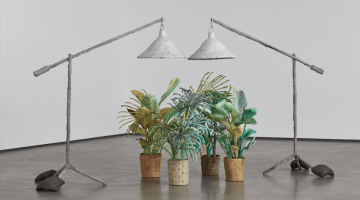A drone so steady and opaque it becomes the sound of amplified silence, opens The Otolith Group’s “’Medium Earth.” A mundane parking structure (location: seemingly anywhere USA) synchronizes with the drone, as it rhythmically pans across the screen. The tail end of a Ford Explorer (or something like it) uneventfully floats into the frame. Low-lying is the point of view, scrolling downward while settling for an instant on its California license plate. Now, zeroing in, the pace quickens and descends toward a deep crack on the ground of this structures’ cement. Almost Lynchian, the drone sound morphs into a dramatic score penetrated with high-pitched eeks and bleeps, as the viewer plummets into the dark void of the narrow fissure.
Recovering from the depths, an expansion of rocks juxtaposed with a robin’s egg blue sky emerges, the drone evens to the likeness of winds and cicadas. Here is the unmistakable sight and sound of a Californian desert. A mountain of dusty avalanche prone, Mars-like rocks teeters atop each other. Slowly, the loose granite transitions to a sidelong cross-section view of a canyon wall, thick folds of rock glide along like rippled fabric formed over millennial. Once again, a drone begins this time it is that of a freeway. The expansive desert with its wide field of vision descends to a new view, modern man’s roads.
London based collective The Otolith Group helmed by founders Anjalika Sagar and Kodwo Eshun, teamed with REDCAT to present a 41-minute video essay “Medium Earth,” that outlines, “stillness of sedentary life and the slowness of cinematic time.” This visual presentation, a glimpse into this collectives proposed future films, utilizes the visible to speak of that which is not seen, namely: seismic activity. The tectonic drama unfolding beneath Earth’s surface manifests in the manmade: breakages in concrete and mans futile repairs on the roads (one can also argue its presence in the glimpse of the magnified desert floor, cracked and moisture thirsty). The film itself is poetic and speaks to a Southern California condition. Indeed, the pace is meticulous but keeps a visual rhythm throughout, reminding the viewer of the textured beauty and natural grace of this terrain. “Medium Earth,” commands a meditative state, but the visual inspires an appreciation. As exhibition essayist, Aram Moshayedi notes, “Medium Earth” turns the desert landscape’s otherwise mute inhabitants into characters whose gravitas unfolds within the frame of cinematic time.”
For more information visit here.
-Contributed by Bianca Guillen





